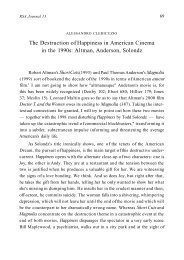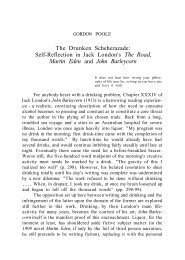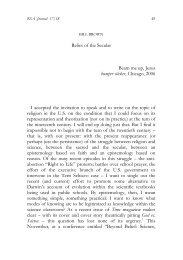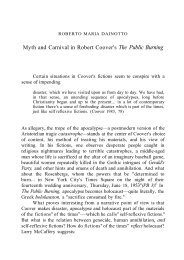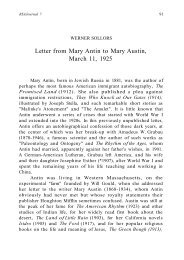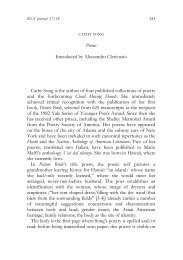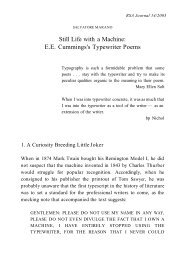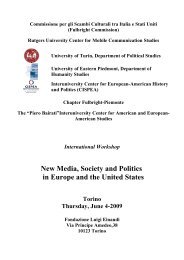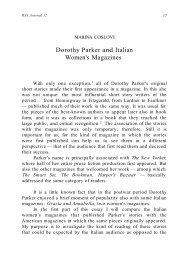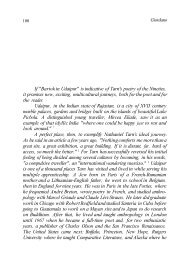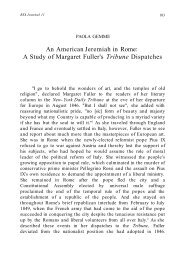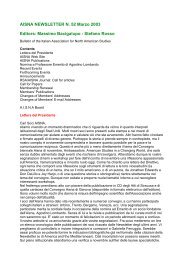NEWSLETTER #56 - aisna
NEWSLETTER #56 - aisna
NEWSLETTER #56 - aisna
You also want an ePaper? Increase the reach of your titles
YUMPU automatically turns print PDFs into web optimized ePapers that Google loves.
AISNA Newsletter 56, p. 28<br />
Hawthorne especially enjoyed the company of men who led active lives, who trafficked in<br />
politics and business. He would have liked to lead more of such a life, and fancied himself in his<br />
custom-house days as a “son of toil” as he boarded ships and spoke to sea-captains about their<br />
voyages and their cargoes. Brenda Wineapple is quite right when she remarks that “Hawthorne<br />
held on to his government job [as measurer of coal and salt at the Boston Custom-House] not just<br />
because he needed the money or because the country ignored its artists… but because he liked it.”<br />
Hawthorne’s campaign biography of Pierce and his editing (and probable ghost-writing) of<br />
Bridge’s naval adventures along the coast of Africa gave him the illusion that he had stitched<br />
himself into the fabric of history. Men of stature regarded him as a trustworthy ally in spreading<br />
their fame. Commodore Matthew Perry—under whom Bridge had served—called upon Hawthorne<br />
in Liverpool, during the winter of 1854, to beseech Hawthorne to write the epic story of his<br />
triumphant voyage the previous year to “open” Japan to the West. “He was good enough to say that<br />
he had fixed upon me, in his own mind, for this office,” Hawthorne wrote in his journal, “but that<br />
my public duties would of course prevent me from engaging in it, I spoke of Herman Melville.”<br />
Perry, alas, did not want the disreputable author of Typee romancing Japan, and did the job himself.<br />
Hawthorne did in fact play an indirect part in the opening of Japan, though he could not have<br />
known it. If Commodore Perry’s gunboat diplomacy opened Japan to Western trade, it was the<br />
work of two Salem men of the next generation, the scientist Edward Sylvester Morse and the art<br />
historian Ernest Fenollosa, who contributed more than anyone else to the cultural opening of Japan.<br />
Morse, a zoologist who became the world’s expert on Japanese ceramics and architecture and was<br />
the longtime director of the Peabody-Essex Museum in Salem, arrived in Yokohama in 1877. He<br />
carried in his pocket, as a reminder to notice things, a journal entry from Hawthorne:<br />
Begin to write always before the impression of novelty has worn off from your mind,<br />
else you will be apt to think that the peculiarities which at first attracted you are not<br />
worth recording; yet these slight peculiarities are the very things that make the most<br />
vivid impression upon the reader. Think nothing too trifling to set down, so it be in the<br />
smallest degree characteristic. You will be surprised to find, on re-perusing your<br />
journal, what an importance and graphic power these little peculiarities assume.<br />
Morse’s account of Japan made such a vivid impression on New Englanders like Henry<br />
Adams, Isabella Stewart Gardner, and Percival Lowell that they were determined to travel to Japan<br />
and see what he had seen. Morse, through his writings and lectures, was largely responsible for the<br />
“Japan vogue” in Gilded Age New Engand. Morse enlisted Fenollosa, a recent granduate of Harvard,<br />
to join him at Tokyo Imperial University and teach political science and Western philosophy.<br />
Fenollosa became enamored of Japanese art and literature instead, and his papers and translations<br />
made their way to Ezra Pound, Fenollosa’s literary executor. Oddly enough, the meaning of Japan for<br />
Fenollosa resided in a smile—the “quiet mysterious smile” of the Buddha and his followers—<br />
reminiscent, he thought, of the Mona Lisa.<br />
Wordslingers: The Western as Genre in Contemporary American Fiction<br />
Marc Chénetier<br />
President, EAAS European Association for American Studies<br />
Professor of American Literature, Université Paris 7 Denis Diderot<br />
Institut Universitaire de France<br />
The real contemporary shooters aim at the genre by means of operations the formulaic cannot live<br />
with. John Hawkes, Paul West, David Markson, Ishmael Reed, Robert Coover, and Gilbert<br />
Sorrentino will serve here, though Richard Brautigan's The Hawkline Monster, Jerome Charyn's<br />
Darlin' Bill, Brian Evenson's "Contagion", William Gass's "The Pedersen Kid", Percival Everett’s<br />
God’s Country and others could have provided relevant illustrations.<br />
To set off what they do, I must explain what Cormac McCarthy doesn't quite. When Grady



